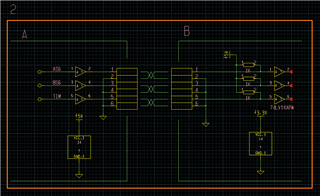Other Parts Discussed in Thread: AM26LV31E
Hello.
I would be grateful if you could answer the following questions.
question
If the negative side of the driver output is shorted to GND, will the device fail due to overcurrent, etc.?
Connect the output Y to 74LV14 through a 1kΩ pull-up resistor and Z to GND as shown in 1.
A is a purchased motor driver, and B is an interface board that we designed ourselves.
The reason for this connection is that A was previously an open collector output as shown in 2.


Originally, ASG/BSG/TIM shown in 1 and 2 were output to B, but they were not used.
It was changed from 2 to 1 and 2 out of 21 units broke down.
One of them is shown in 3. I think you can see that the IC is burnt out.

The motor driver manufacturer explained that the negative side of the differential output was shorted to GND and the signal was added to the input, which led to damage to the device.
However, 19 devices were not damaged, which led to this question.
that's all, thank you very much.
JEOL Ltd. Maeda

